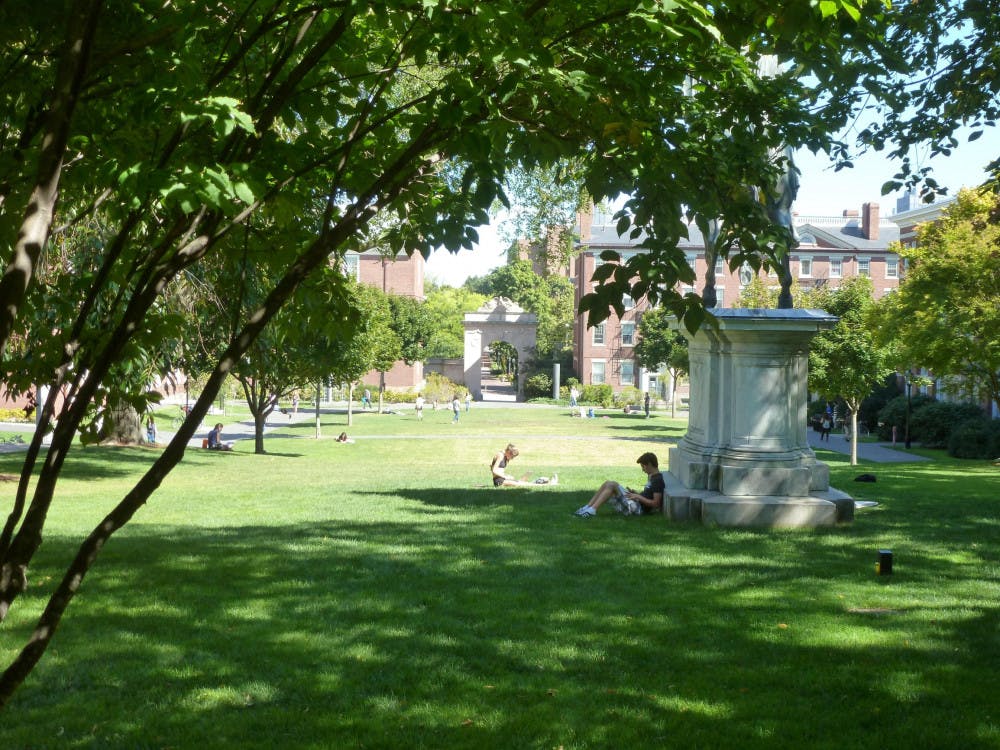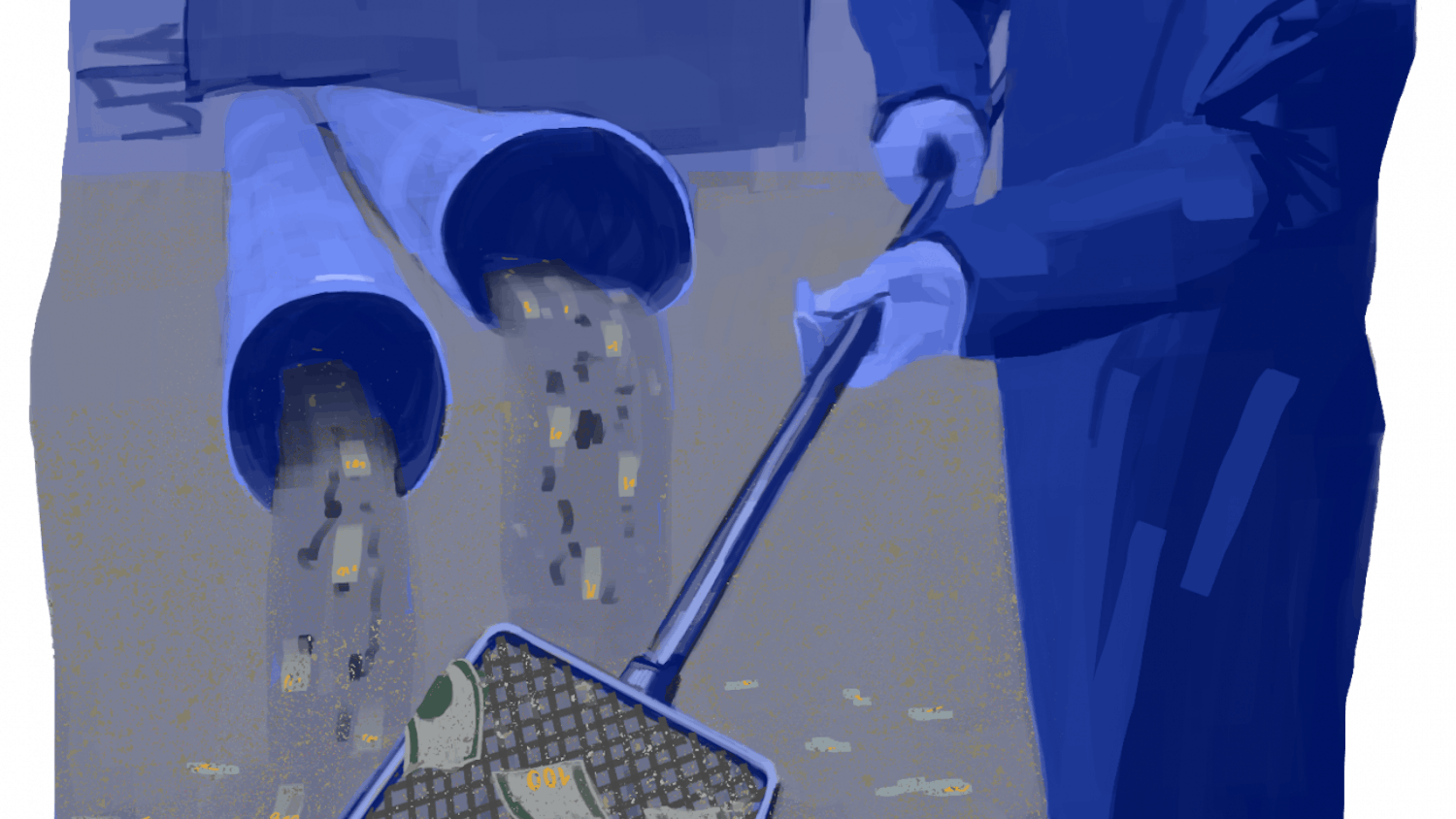Bound on four sides by all varieties of academic disciplines and student life, Lincoln Field, the University's historic lower campus, lacks both the imposing splendor of the Main Green and the sleepy solace of the Quiet Green.
Its sloping expanse has long been a hub of academic life on campus, but it has also been home to the less intellectual but equally valued pursuits of lunch tray sledding, Frisbee slinging and sunbathing.
Until 1880, the space was "nothing more than a swamp ... inhabited by a numerous colony of musical bull-frogs ... bordered with a tropic growth of shrubbery and tall grass," wrote alum Anthony McCabe in "Memories of Brown: traditions and recollections gathered from many sources" - a 1909 compilation of student accounts. In 1880, the swamp was formally laid out and named Lincoln Field.
Upon former President Ruth Simmons' departure earlier this year, the Corporation, the University's highest governing body, formally rededicated the land as the Ruth J. Simmons Quadrangle.
Honorary naming and dedication is a responsibility of the Corporation, said Richard Spies, interim senior vice president for University advancement. There are no formal rules governing the process, but the members try to proceed in "an orderly fashion," he said.
"They are the stewards of the physical spaces and assets of the University," Spies said. "Ultimately the decision about naming something would be theirs."
Currently, there are no plans to commemorate Professor John Lincoln, the quadrangle's original namesake, in an alternate way. "It does happen in some cases that buildings are demolished and names disappear," Spies said. "The memories are usually captured somehow, but not always."
(A)Live on Lincoln
John Larkin Lincoln 1836 was a Latin professor at the University from 1844 until his death in 1891. References to Lincoln's character and teaching are frequently scattered throughout "Memories," often taking the form of reminiscences on his academic prowess, imposing presence and sharp sense of humor.
By most accounts, Lincoln seems to have been one of the professors originally responsible for making the University's name synonymous with great teaching. While Simmons was often considered a rock star at Brown, stories suggest that Lincoln may have been one of her 19th century equivalents.
"Seniors were frequently invited to his table, and they adored him," wrote Benjamin Wheeler 1875 in "Memories." "I was sure no college had such remarkable professors as Brown," he wrote.
Lincoln also showed great enthusiasm both for the Latin language and for teaching. "How he beamed and glowed over a happy translation ... How he radiated his own joy in the Ars Poetica!" wrote former University president William Faunce 1880 of his colleague. "Latin a dead language? No one ever said that who sat under 'Johnny Link' in 23 University Hall."
The pieces also recount tales of Lincoln's quick wit and dry sense of humor. One unfortunate student, caught off-guard in class by a question about the Roman historian Livy, replied that he had forgotten the answer, James Angell 1849 recalled. Lincoln's retort was devastating: "Forgotten? Did you ever know?"
Adoration aside, the classics professor was equally talented in the discipline of his young charges. "Students in that group will never forget the impressive and indignant manner with which Professor Lincoln fixed his eyeglasses and glared through the window at the offenders," wrote August Swift of an incident involving former University president Francis Wayland's dairy cow and an incessantly ringing University bell.
Lincoln's name will live on in history books, but how deeply attached it will be to the field in the future remains to be seen. "Is the Lincoln name removed, or is it in effect shared?" Spies asked. "I don't know the answer to that yet."
Battleground
Throughout the years, thousands of students have used the field as a sun-drenched spot for studying, sports and a bit of lounging between classes.
But in the 1800s, the field had yet to be surrounded by its current array of academic buildings. Baseballs flew freely - until one crashed unceremoniously through the window of St. Stephen's Church, leading to a hasty reorientation of home plate.
The ability to bring together a community, whether through a 19th century baseball team or a 21st century dance class, seems to be a long-standing feature of the space. Each spring, hundreds now gather on the field for an evening of traditional African Mande dance. In years past, sporting events were the major draw for crowds.
The quad has also witnessed its fair share of mischief over the years - even Victorian-era Brunonians were not without the characteristic streak of sly troublemaking.
On a spring night in 1899, students celebrating a baseball victory over Princeton set the field alight with bonfires on a "never-to-be-forgotten night on Lincoln Field," an unidentified student wrote in "Memories." It was an event perhaps responsible for setting the precedent for an age-old struggle well-known to any student who has ever called Keeney Quadrangle home.
The bonfires "transformed the arena of Lincoln Field into a battleground," he wrote. "The warring factions were the students of Brown University and the fire department."
In perpetuity?
On the opening day of the 2012-2013 academic year, bewildered first-years and transfer students consulted freshly labeled maps directing them through the Simmons Quadrangle. After the Van Wickle gates swing inward to admit three more classes, the field's original name may be lost to all but historians and alums.
But for three-quarters of the current undergraduate community, the majority of memories related to the field - Fall Concert, Live on Lincoln and the annual Foam Party, to name a few - will exist under a different name, at least for now.
Though the name does not yet roll easily off the tongue, most upperclassmen and recent alums seem to be aware of the change. Juan Lorenzo '12, who had just informed his friend Cristina Alvarez '13 of the new title, said he thinks the quad is desper
ately in need of a nickname.
But both thought the name would catch on fairly rapidly "because Ruth was so adored," Lorenzo said. And they agreed that Simmons deserved the remembrance.
"It's a huge honor," said Briana Garcia '14. "It's one of my favorite greens on campus."
Several more recently dedicated buildings have yet to answer to their name in the minds of students. New Dorm seems almost certainly entrenched as the unofficial title for the Vartan Gregorian Quad and Faunce House is still fairly universally the name of choice for the Stephen Robert '62 Campus Center.
"Some things are instantaneously accepted, and other things take forever," Spies said. "Sometimes four years is a reasonable estimate of 'a while' before they become part of the popular lexicon, but some things happen a lot faster."
The Corporation's resolution of gratitude towards Simmons states, "In high honor and lasting legacy of her Presidency, the historic lower campus between Soldier's Arch and Sayles Hall will be henceforth and in perpetuity known to all as The Ruth J. Simmons Quadrangle."
"There's a time and a place for everything, including naming," Spies said of campus rededications. "Not everything is forever."
More than 100 years later, student knowledge of the once illustrious Professor Lincoln has all but faded from memory, raising a lingering question.
Centuries later, in perpetuity even, what remains of a name? Even one as powerful as Ruth J. Simmons.





